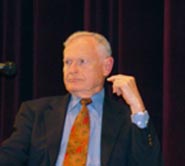It’s safe to say that the last thing a woman in labor is thinking about is a Czanne painting, and a man with terminal cancer is most likely not pondering Edward Hopper’s use of shadow in “Nighthawks.”
The link between medicine and art is an unlikely one.
However, Dr. Sherwin Nuland, Clinical Professor of Surgery at Yale University School of Medicine, gave a lecture in Dana Auditorium entitled, “The Artist Looks at the Doctor: 500 Years of Observation.” Nuland used art as a historical reference about the evolution of medical knowledge from the thirteenth century to present day.
The lecture included a slide show of paintings from various times in medical history and an explanation of the paintings’ importance as historical documents.
Nuland said at the beginning of his lecture: “medicine will always be an art.”
“As an artist and professor of art history I found the perspective of a doctor to be unusual and interesting,” said Adele Wayman, Professor of Art. “His main interest was in the content, i.e. different aspects artists have chosen to respond to about doctors throughout history – the images of the diseases, treatments of them, both good and bad, images that showed how procedures are done.”
One of the slides Nuland displayed was of a Rafael painting showing the resurrection of Jesus, and his disciples looking up to him in awe and glory. One of the figures in the painting was having an epileptic seizure. Nuland went on to explain that the significance of this painting was its depiction of religion in medical history.
Another painting Dr. Nuland talked about appeared in the eighteenth century. Cadavers were in short supply., so doctors robbed graves in order to find bodies. The medical caricature showed a woman trying to distract a confused doctor from dissecting a living man lying on the lab table.
A third painting showed a turning point in medical history: the first testing of opium-based anesthesia on a patient in 1826. This event opened new doors of opportunity, especially for amputation. Previously, patients were numbed with alcohol.
Nuland’s lecture on Tuesday night was followed by a question-and-answer session. One person asked why Nuland had not shown any contemporary paintings. His answer was that doctors were no longer credited with healing, and that most of their work had been replaced by technology.
Philosophy professor Jonathan Malino, who introduced Nuland, said: “I think I was most struck by the diverse roles art has played during the history of medicine. More than any particular painting, it was the variety purposes that struck me.”
After the lecture, audience member Binford Farlow said: ” This whole series of [Bryan] lectures has been a very stimulating series to the college and the community.” Past speakers of the Bryan lecture series include Colin Powell and Bill Bradley. Playwright Edward Albee, filmmaker Ken Burns, and actor Sidney Poitier will speak later this fall.

